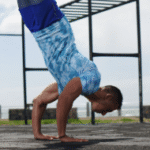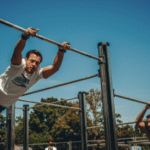What if I Have Injuries? Can Private Calisthenics Still Work?
The core principles of calisthenics inherently align well with the demands of injury management and rehabilitation:
- Infinitely Scalable Resistance (Your Bodyweight): Unlike external weights, bodyweight exercises can be regressed (made easier) or progressed (made harder) in incredibly fine increments by altering leverage, range of motion, stability, or support points. This allows a coach to find a pain-free starting point, no matter how severe the limitation.
- Focus on Form and Control: Calisthenics emphasizes mastering movement patterns with perfect form and body control. This meticulous attention to technique is paramount for safety and for preventing compensation patterns that can aggravate an injury.
- Low Impact: Many calisthenics exercises are low-impact, reducing stress on joints compared to high-impact activities or heavy lifting.
- Emphasis on Mobility and Stability: Calisthenics inherently builds strength through a full range of motion and emphasizes joint stability, both of which are crucial for rehabilitation and preventing future injuries.
- Functional Movement: Calisthenics movements often mimic real-life activities, aiding in regaining functional strength and movement patterns post-injury.
The Crucial Role of the Private Coach When Training with Injuries
A private calisthenics coach is indispensable when working with an existing injury in Houston. Their expertise allows for a safe, effective, and tailored approach:
- Thorough Initial Assessment and Medical History:
The coach will conduct an in-depth assessment, including your complete medical history, details of the injury (diagnosis, onset, aggravating factors, alleviating factors), pain levels (e.g., using a 0-10 scale), and any specific contraindications or movements to avoid.
Crucially, they will ask for and adhere to medical clearance from your physician or physical therapist (PT). A professional coach understands their scope of practice and will not diagnose or treat the injury, but rather design a training program that complements your medical rehabilitation.
- Collaboration with Medical Professionals:
A highly effective private coach will actively seek to collaborate with your physical therapist, doctor, or chiropractor . They can communicate about your rehab protocol, understand safe ranges of motion, and align the strength training with your medical recovery plan. This integrated approach maximizes safety and optimizes outcomes.
- Personalized Program Design Around the Injury:
The coach will design a program specifically tailored to avoid aggravating the injured area while still providing a training stimulus to the rest of your body and, importantly, the muscles supporting the injured area.
They focus on strengthening surrounding and supporting muscles, which can provide stability and offload stress from the injured joint or tissue.
- Strategic Regressions (Making it Pain-Free):
This is where calisthenics truly shines for injuries. The coach will identify the specific calisthenics regressions that allow you to perform the exercise without pain .
Examples:
Shoulder/Elbow/Wrist Injury: Instead of push-ups, you might start with wall push-ups, then incline push-ups at varying heights. Instead of pull-ups, begin with Australian rows or even just isometric holds. Specific wrist conditioning and mobility drills will be integrated. Using gymnastics rings can be beneficial for upper-body workouts as they allow for a more natural and varied forearm position, reducing stress on affected tendons.
Lower Back Pain: Focus on perfecting core engagement (e.g., dead bug, bird-dog variations) and neutral spine positioning. Squats might start with chair squats or box squats to limit depth.
Knee Injury: Instead of deep squats or lunges, begin with wall sits, glute bridges, calf raises, or squats to a very high box. Resistance bands can be used for terminal knee extensions or glute activation. Avoid deep squats, lunges, and positions that put a lot of stress on the knees until cleared.
Ankle Sprain: Focus on seated upper body work, then gradual reintroduction of lower body exercises with stability support (e.g., holding onto a chair for balance during squats) and targeted ankle mobility drills.
- Targeted Corrective Exercises:
Beyond regressions, the coach will incorporate specific corrective exercises designed to address muscle imbalances, improve mobility, and enhance stability around the injured joint, helping to rebuild function and resilience.
- Meticulous Form Correction:
A private coach’s constant, real-time feedback is crucial to prevent compensatory movement patterns that can emerge due to pain or weakness. These compensations, if left uncorrected, can lead to further injury or prolong recovery.
- Safety Protocols and Spotting:
The coach ensures all exercises are performed in a safe environment, with appropriate padding (mats) and spotting when necessary. They will guide you safely through movements, avoiding positions that could aggravate your injury.
- Emphasis on Client Communication and “No Pain, No Train”:
A fundamental rule: if it causes sharp or persistent pain, stop immediately. The coach will emphasize open communication, encouraging you to report any discomfort. They understand the difference between muscle fatigue and true pain.
They will never push you through pain that indicates injury.
- Progressive Reintroduction:
As recovery progresses, the coach will gradually and safely reintroduce more challenging movements, carefully monitoring your body’s response and ensuring the injured area is adapting.
- Education:
The coach educates you on how to move safely, how to modify exercises yourself, and how to differentiate between healthy muscle soreness and pain that indicates an issue.
Important Considerations in Houston:
Finding the Right Coach: In Houston, look for private calisthenics coaches with experience working with injured clients. They may have additional certifications in corrective exercise or have strong referral networks with physical therapists. Gyms like Mekanix Gym in Houston, for instance, specifically mention injury rehabilitation in their calisthenics personal training programs, indicating a focus on safe and effective progression.
Medical Clearance: Always obtain clearance from your doctor or physical therapist before starting any new exercise program with an injury.
Patience: Recovery takes time. A good coach will emphasize patience and consistency over rushing the process.
In conclusion, yes, private calisthenics training can absolutely work, and often thrives, when you have existing injuries. Its inherent adaptability through precise regressions, coupled with the meticulous guidance of a qualified private coach who prioritizes safety, form, and collaboration with medical professionals, makes it an exceptionally effective and safe pathway for rebuilding strength, improving mobility, and achieving your fitness goals while navigating and rehabilitating from physical limitations in Houston.

What if I Have Injuries? Can Private Calisthenics Still Work?
Route
Calisthenics Gym Houston Functional Bodyweight Training
Secondary phone: (346) 483-3195
Email: info@calisthenicsclubhouston.com
URL: https://calisthenicsclubhouston.com/
Monday 6:00 AM - 7:00 PM Tuesday 6:00 AM - 7:00 PM Wednesday 6:00 AM - 7:00 PM Thursday 6:00 AM - 7:00 PM Friday 12:00 PM - 6:30 PM Saturday 9:45 AM - 12:00 PM Sunday 3:00 PM - 5:00 PM





